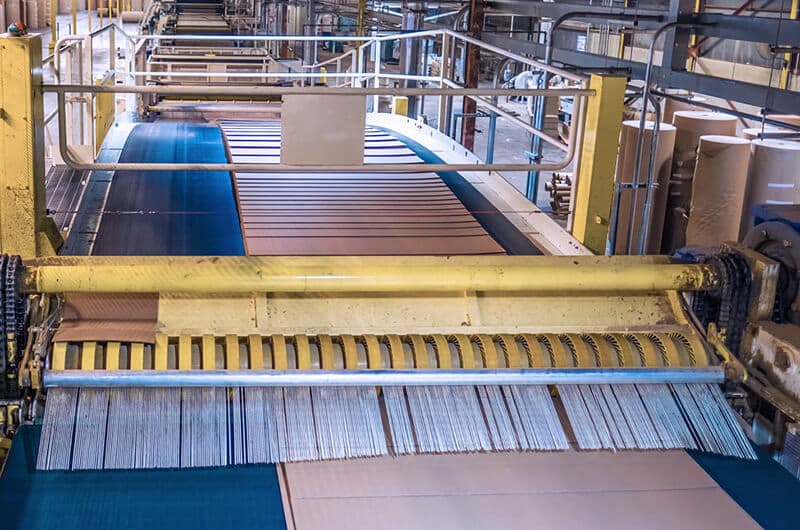eMaint CMMS helps cardboard producer meet soaring product demands
Customer Since: 2017 | Corrugated Cardboard
Canada’s largest independent corrugated producer, Tencorr Packaging, manufactures 2.2 billion square feet of corrugated cardboard each year at its two Ontario plants. The demand for Tencorr’s product has skyrocketed because of the rapid rise in shipping materials needed by ecommerce giants such as Amazon to serve their customers buying online.
An hour of equipment downtime at one of its plants can equate to a $10,000 loss of output. The company determined it needed a computerized maintenance management system (CMMS) to manage its thriving business. Tencorr chose eMaint in 2017 because the CMMS could easily be configured to meet the company’s needs and could expand as the business grows.

BACKGROUND
With consumers increasingly shifting to ecommerce over in-store visits, purchases of corrugated cardboard for shipping materials have zoomed upward. Tencorr Packaging needed to ensure that its Brampton and Mississauga plants could meet the market demands efficiently.
When Bill Strachan, Director of Manufacturing at Tencorr, came to the company, he and other leaders of the organization agreed that a CMMS was required to manage the additional demands on equipment and maintenance operations. eMaint offered Tencorr powerful capabilities, customizable features, scalability, and a reputation for providing customers with exceptional training and support.

THE CHALLENGE
Tencorr’s assets include an array of pumps, hydraulics, and electrical components that make up a 100-foot-long machine called a corrugator that is used to create the product. The machine’s rollers and roller bearings are critical assets and integral to production. Teams also maintain periphery assets, such as large forklifts and clamp trucks that grab and move large, heavy rolls of paper to the machine.
When Strachan joined Tencorr, the company used outmoded methods for assigning and recording maintenance work. Legacy asset information resided solely in the heads of workers, and preventive maintenance schedules were based on someone tracking things based on memory. Maintenance teams commonly logged work manually and used sheets of paper to document repairs and completions.
Team members were often uncertain what parts were available for a repair and locating the one needed was a challenge. Sometimes, costly parts were reordered even though they were actually sitting on the shelf.
IMPLEMENTATION
CMMS training took priority at Tencorr’s two plants. Most maintenance team members were unfamiliar with the software’s capabilities. Strachan knew it would be important to identify a leader at each plant to champion the CMMS implementation and place them in the trenches with the teams.
Plant maintenance leaders began by optimizing and automating workflows, and ensured thousands of parts were input and cataloged. CMMS adoption gained significant traction once eMaint training experts came onsite to provide in-person instruction to Tencorr’s maintenance teams.
“Having the trainer here, going through specifics, running it in the sandbox where they would not be intimidated or concerned with making mistakes was a turning point,” Strachan explained. “I think that really helped our users.”
RESULTS
With Tencorr’s maintenance teams taking advantage of the system’s robust asset-management features, production outputs have increased by 20% in less than three years. Additionally, the company’s Brampton plant realized a 38% reduction in downtime and its Mississauga plant saw a 31% reduction, enabling world-class maintenance status for both facilities.
Strachan uses eMaint’s real-time dashboard data and reporting features to display and analyze operations and develop plans for future improvements. Teams appreciate the ability to view parts easily in the system and see exactly where to find a part, saving everyone headaches, grief, time, and money.
FUTURE
Because some assets are so critical to production, Tencorr is considering placing Fluke wireless vibration monitoring sensors on some of its equipment to ensure asset reliability.
“I’m starting to look at not just preventative maintenance, but predictive maintenance,” Strachan said. “I want to be able to know before an asset fails, so that we can have things under control — have the part on hand, have the repair scheduled — instead of having to react to it breaking down.”
BENEFITS
“The first year I was here after I put eMaint in, year-over-year we increased about 14%. The year after that we increased about 6%, and this past year we increased 8%. That’s over 20% in the last three years, and I would say a good portion of that is because we have our maintenance a little bit more in control now.”
“The first year I was here after I put eMaint in, year-over-year we increased about 14%. The year after that we increased about 6%, and this past year we increased 8%. That’s over 20% in the last three years, and I would say a good portion of that is because we have our maintenance a little bit more in control now.”
Bill Strachan, Director of Manufacturing at Tencorr
